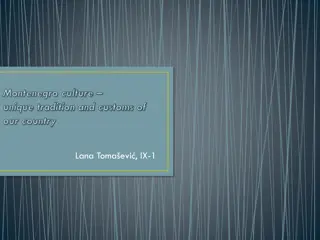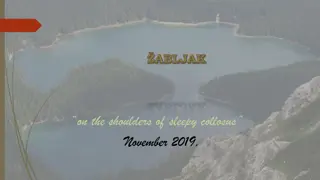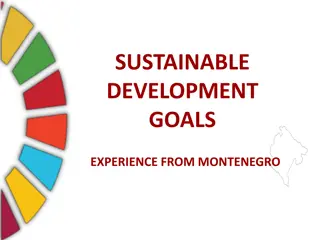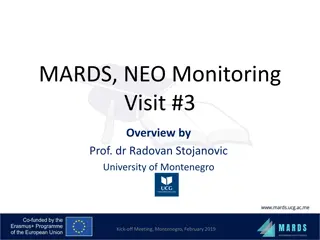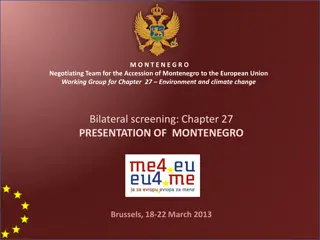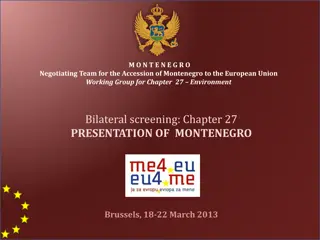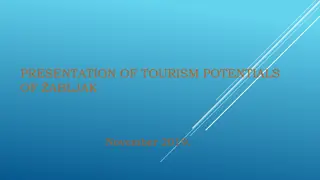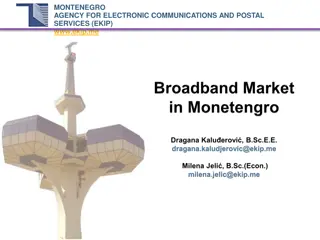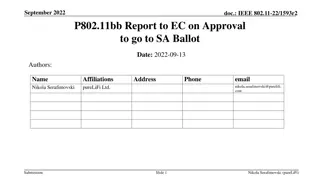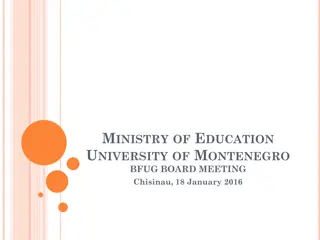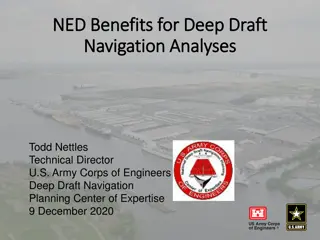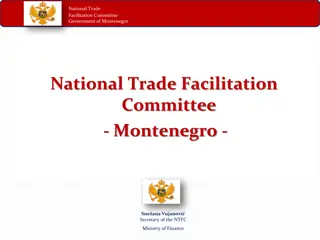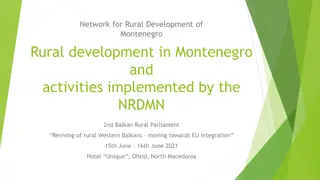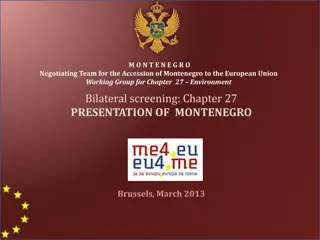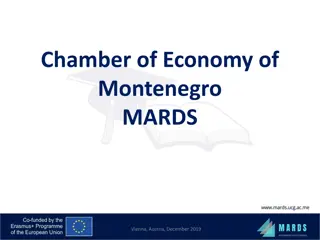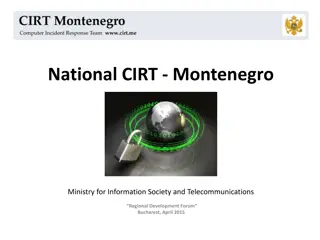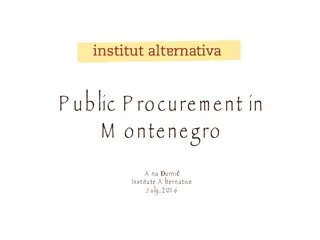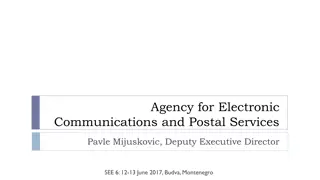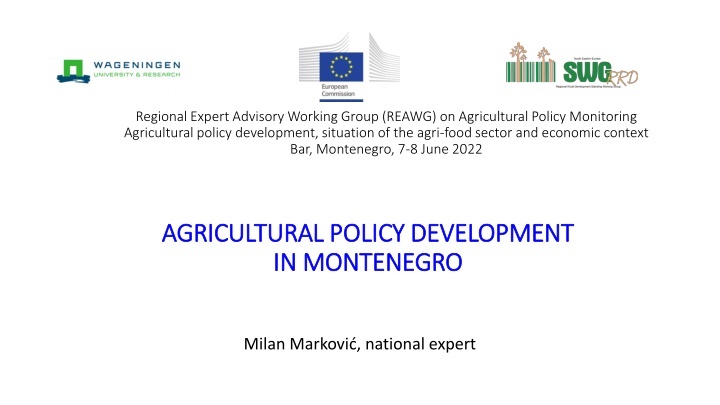
Agricultural Policy Development and Budgetary Support in Montenegro 2022
Explore the agricultural policy development and budgetary support measures in Montenegro, focusing on greener policy instruments, EU approximation process, and the utilization of agricultural areas. Learn about the evolution of the agricultural policy framework, the national programme for food production, and rural development. Delve into the total budgetary support plan for agriculture in Montenegro, including measures for market support, structural and rural development, and other related areas.
Download Presentation

Please find below an Image/Link to download the presentation.
The content on the website is provided AS IS for your information and personal use only. It may not be sold, licensed, or shared on other websites without obtaining consent from the author. If you encounter any issues during the download, it is possible that the publisher has removed the file from their server.
You are allowed to download the files provided on this website for personal or commercial use, subject to the condition that they are used lawfully. All files are the property of their respective owners.
The content on the website is provided AS IS for your information and personal use only. It may not be sold, licensed, or shared on other websites without obtaining consent from the author.
E N D
Presentation Transcript
Regional Expert Advisory Working Group (REAWG) on Agricultural Policy Monitoring Agricultural policy development, situation of the agri-food sector and economic context Bar, Montenegro, 7-8 June 2022 AGRICULTURAL POLICY DEVELOPMENT AGRICULTURAL POLICY DEVELOPMENT IN IN MONTENEGRO MONTENEGRO Milan Markovi , national expert
Content Content Agricultural policy framework Measures and budgetary support of agriculture and rural development Greener policy instruments and measures EU approximation process Open issues Interim Meeting, Bar, 7-8 June 2022 2
UTILISED AGRICULTURAL AREA: Montenegro vs WB and EU countries PG in MNE 94%! Source: FAO - Agricultural Policy and European Integration in Southeastern Europe, 2014 Interim Meeting, Bar, 7-8 June 2022 3
AGRICULTURAL POLICY FRAMEWORK AGRICULTURAL POLICY FRAMEWORK The evolution of the agricultural policy development and its harmonisation with CAP of EU The Strategy from 2006 was a turning point in designing agricultural policy and cornerstone for the existing AP The National programme of food production and rural development 2009-2013 (adopted in 2008) developed clear frame for the agricultural policy 1st pillar Market and direct producer support - 9 measures, 29% 2nd pillar Structural and rural development 17 measures, 39% 3rd pillar General services in agriculture 8 measures, 18% Other measures (social transfer to rural population - 1 measure 11.2% + techn. support 2.5%) The Law on agriculture and rural development (2010) transferred strategic guidance to the legal frame for the agricultural policy Implementation of AP The Decree on regulation of conditions, implementation dynamics of agricultural policy measures on the annual level so called Agrobudget. Interim Meeting, Bar, 7-8 June 2022 4
THE PLAN THE PLAN OF TOTAL BUDGETARY SUPORT TO AGRICULTURE OF TOTAL BUDGETARY SUPORT TO AGRICULTURE, , in mil. euro in mil. euro 60 Other measures related to agriculture 50 40 30 Structural and rural development measures 20 10 Market and direct producer support measures 0 12 13 14 15 16 17 18 19 20 21 Note: The execution in 2018th and 2019th 5
Total budgetary support per inhabitant 2006-20012 (EUR) 180 EU 160 Croatia 140 Albania 120 B&H 100 Macedonia Montenegro 80 Serbia 60 40 20 0 2005 2006 2007 2008 2009 2010 2011 2012 In 2012: In 2012: EU27=100% HRV ALB BiH MKD MNE SRB 74 74 5 5 14 14 31 31 15 15 20 20 Source: FAO - Agricultural Policy and European Integration in Southeastern Europe, 2014 3/19/2025 6
BUDGETARY TRANSFERS FOR MARKET AND DIRECT PRODUCERS MEASURES BUDGETARY TRANSFERS FOR MARKET AND DIRECT PRODUCERS MEASURES, , in million euro in million euro 14 12 Input subsidies 10 8 Direct payments 6 4 2 Market support measures 0 12 13 14 15 16 17 18 19 20 21 7
THE PLAN THE PLANOF OF BUDGETARY TRANSFERS FOR STRUCTURAL AND RURAL BUDGETARY TRANSFERS FOR STRUCTURAL AND RURAL DEVELOPMENT MEASURES DEVELOPMENT MEASURES, mil.euro , mil.euro 40 35 Rural economy and population 30 25 20 Environment and societal services 15 10 5 Competitiveness 0 12 13 14 15 16 17 18 19 20 21 8
BUDGETARY TRANSFERS FOR GENERAL SERVICES BUDGETARY TRANSFERS FOR GENERAL SERVICES IN AGRICULTURE IN AGRICULTURE 10 9 Other general support 8 7 6 5 Food safety 4 3 2 1 R&D and expert services 0 12 13 14 15 16 17 18 19 20 21 9
TOTAL BUDGETARY SUPPORT TO AGRICULTURE by sources (million EUR) 60 Other international funds 50 40 30 EU_CAP funds 20 10 National sources 0 12 13 14 15 16 17 18 19 20 21 EU support is IPARD The following measures are currently operational: M 1: "Investments in physical assets of agricultural holdings" M 3: "Investments in physical assets concerning processing and marketing of agricultural and fishery products" Indicative IPARD II budget as initially planned in 2014 (amounts in Million EUR) 2014 2015 2016 2017 2018 2019 2020 Total Montenegro 0 5 Interim Meeting, Bar, 7-8 June 2022 5 6 7 8 8 39 10
MAIN SUCCESS AND FAILURES OF THE AGRICULTURE POLICY INSTRUMENTS AND MAIN SUCCESS AND FAILURES OF THE AGRICULTURE POLICY INSTRUMENTS AND MEASURES IN 2020 MEASURES IN 2020 and and 2021 2021 Successes: Total budget for agriculture is increased The procedures for submission of applications, on spot control and payment ecxecution of the rural development measures are improved significantly due to IPARD implementation Unit of MAFWM - Directorate for payments - new employees recruited, procedures are established and implemented (Public call for measures) Failures: Significant number of the professional staff members left the Ministry The number of measures of RD policy increased from 17 in 2009 to 25 in 2021, even 19 in the Axis One The amounts of the coupled payments is increased Introduction of the new direct support measures - non CAP compliant Direct payments in sensitive sectors, e.i. in 2009 sheep sector 10 euro per head, while in 2020 only 8 euro per head, with a threshold of 30 animals to be eligible for support As a consequence: negative trends in the agri-food sector remain: huge trade deficit, decrease in the number of cattle, sheep and goats; depopulation and aging of the rural areas 11
Greener policy instruments and measures Greener policy instruments and measures There are 4 measures in the second axis the second axis of the Rural development policy: Merasure 2020 2021 Support to Organic agriculture 400,000 450,000 Suport the plant and animal genetic resources 40,000 60,000 Support for using mountain pastures 250,000 250,000 Support to manure handling 90,000 60,000 First three measures have been implemented after the adoption of the National program in 2008 A scope and total amount of Support to the genetic resources are very modest, in 2009 it was 80,000 euro! Interim Meeting, Bar, 7-8 June 2022 12
EU APPROXIMATION PROCESSES EU APPROXIMATION PROCESSES Chapter 11: Agriculture and rural development Chapter 11: Agriculture and rural development For the closing of Chapter 11, Montenegro received 2 final criteria: Benchmark I - Implementation plan for the establishment of the Integrated Administration and Control System (IACS), including the establishment of a Land Parcel Identification System (LPIS). Benchmark II The plan for the establishment of the Paying Agency, fully operational until accession, taking into account the standards of independence, reliability, accountability and sound financial management Progress achieved: (Quoted from the EU Progress report 2021) Montenegro remains moderately prepared in the area of agriculture and rural development. Some progress was achieved on last year s recommendations, mainly in the implementation of the instrument for pre-accession assistance for rural development programme (IPARD II) through further calls and entrustment of one further IPARD measure. The implementation of the action plan on EU acquis alignment was limited. In the coming year, Montenegro should in particular: step up the implementation of the IPARD II programme, seek entrustment for implementing the Technical assistance measure and submit the draft IPARD III 2021- 2027 programme to the Commission for adoption; continue to implement the action plan for alignment with the EU acquis on agriculture and rural development, and adopt the strategy for agriculture and rural development 2021- 2027 Interim Meeting, Bar, 7-8 June 2022 13
EU APPROXIMATION PROCESSES EU APPROXIMATION PROCESSES Chapter 12: Food safety, veterinary and phytosanitary policy For the closure of Chapter 12, Montenegro received 3 final benchmarks: I) National program for the improvement of facilities for products of animal origin, including facilities for animal by-products and the National program for the use of raw milk. II) System of official control of live animals and products of animal origin, including guarantees of developed administrative structures III) Administrative capacity for proper implementation of the entire Acquis covered by this chapter. Progress achieved: (Quoted from the EU Progress report 2021) Montenegro remains moderately prepared on this chapter. Good progress was made on previous year s recommendations, in particular on in implementing the national strategy for aligning with and implementing the EU acquis. The upgrading of establishments and the implementation of programmes continued. In the coming year, Montenegro should in particular: continue to implement the revised strategy for aligning with and implementing the EU acquis; continue to support the ongoing process of upgrading food establishments; continue to strengthen administrative capacity and infrastructures, in particular on food safety controls and implement robust disease surveillance and vaccination, as applicable. Interim Meeting, Bar, 7-8 June 2022 14
EU APPROXIMATION PROCESSES EU APPROXIMATION PROCESSES Chapter 13: Fisheries For the closure of Chapter 13, Montenegro received 2 final criteria: I) Three laws - Law on Structural Measures and State Aid, Law on Market Organization and Law on Marine Fisheries II) Administrative capacities - inspection and control fully qualified Progress achieved: (Quoted from the EU Progress report 2021) Montenegro has some level of preparation in this area. Limited progress was made in the reporting period on the recommendations of the last report, which remain valid. Montenegro continued to be a reliable partner in international fora. In the coming period, Montenegro should in particular: finalize its work in preparation of the new fisheries and aquaculture strategy with the action plan on aligning with and enforcing the EU acquis; continue to strengthen administrative, data collection, scientific advice, inspection and control capacities. continue, within the General Fisheries Commission for Mediterranean (GFCM) the implementation of the multiannual plan for demersal species in the Adriatic. Interim Meeting, Bar, 7-8 June 2022 15
Open issues Open issues Montenegro is being late with preparation of the new Strategy - the existing one was for period 2015 2020! Lack of transparency - no publicly available data on the budgetary expenses for agriculture The municipalities (not all) provide support for agriculture, in the majority cases that support is a just copy of the direct payments from state level (e.i. milk subsidies) or additional input subsidies (seeds and seedlings etc.) The gap between EU CAP and Montenegrin Agri policy is getting bigger commercial milk producers are getting more from this modest budget while support for ruminants (sheep, goats and cattle) in the distant rural areas are at the same level or even smaller than 12 years ago! There is still no multiannual financial framework of budgetary support to agriculture There is no reporting The needed changes in politics should not severely affect the POLICY POLICY! Interim Meeting, Bar, 7-8 June 2022 16
Thank you for your attention! 3/19/2025 17

